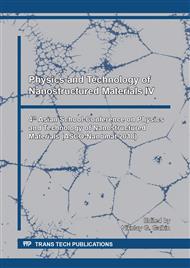[1]
D.B. Migas, V.L. Shaposhnikov, V.E. Borisenko, Isostructural BaSi2, BaGe2 and SrGe2: electronic and optical properties, Phys. Stat. Sol B. 244 (2007) 2611.
DOI: 10.1002/pssb.200642556
Google Scholar
[2]
T. Nakamura, T. Suemasu, K.-I. Takakura, F. Hasegawa, A. Wakahara, M. Imai, Investigation of the energy band structure of orthorhombic BaSi2 by optical and electrical measurements and theoretical calculations, Applied Physics Letters 81 (2002).
DOI: 10.1063/1.1498865
Google Scholar
[3]
A. Pokhrel, L. Samad, F. Meng and S. Jin, Synthesis and characterization of barium silicide (BaSi2) nanowire arrays for potential solar applications, Nanoscale 7 (2015) 17450.
DOI: 10.1039/c5nr03668b
Google Scholar
[4]
M.A. Khan, K.O. Hara, W. Du, M. Baba, K. Nakamura, M. Suzuno, K. Toko, N. Usami, T. Suemasu, In-situ heavily p-type doping of over 1020 cm−3 in semiconducting BaSi2 thin films for solar cells applications, Applied Physics Letters 102 (2013).
DOI: 10.1063/1.4796142
Google Scholar
[5]
R. Takabe, K. Nakamura, M. Baba, W. Du, M.A. Khan, K. Toko, M. Sasase, K.O. Hara, N. Usami, T. Suemasu. Fabrication and characterization of BaSi2 epitaxial films over 1 µm in thickness on Si(111), Jap. J. Appl. Phys. 53 (2014) 04ER04.
DOI: 10.7567/jjap.53.04er04
Google Scholar
[6]
K. Morita, Y. Inomata, T. Suemasu, Optical and electrical properties of semiconducting BaSi2 thin films on Si substrates grown by molecular beam epitaxy, Thin Solid Films 508 (2006) 363.
DOI: 10.1016/j.tsf.2005.07.344
Google Scholar
[7]
Y. Matsumoto, D. Tsukada, R. Sasaki, M. Takeishi, T. Suemasu, Photoresponse Properties of Semiconducting BaSi2 Epitaxial Films Grown on Si(111) Substrates by Molecular Beam Epitaxy Applied Physics Express 2 (2009) 021101.
DOI: 10.1143/apex.2.021101
Google Scholar
[8]
D.V. Fomin, V.L. Dubov, K.N. Galkin, N.G. Galkin, R.I. Batalov and V.A. Shustov, Formation and properties of crystalline BaSi2 thin films obtained by solid phase epitaxy on Si(111) JJAP Conf. Proc. 5 (2017) 011203.
DOI: 10.56646/jjapcp.5.0_011203
Google Scholar
[9]
D.V. Fomin, V.L. Dubov, K.N. Galkin, D.L. Goroshko, A.M. Maslov, N.G. Galkin, R.I. Batalov and V.A. Shustov, Formation, structure and optical properties of nanocrystalline BaSi2 films on Si(111) substrate Sol. St. Phenom. 245 (2016) 42-48.
DOI: 10.4028/www.scientific.net/ssp.245.42
Google Scholar
[10]
R. Mcgehee, J. Renault, The Use of Standard Deviation of X-ray Diffraction Lines as a Measure of Broadening in the Scherrer Equation: A Curve Fitting Method, J. Appl. Cryst. 5 (1972) 365.
DOI: 10.1107/s002188987200977x
Google Scholar
[11]
Crystallography Open Database (COD), http://www.crystallography.net #8103005 Ba2Si4.
Google Scholar
[12]
V.I. Gavrilenko, A.M. Grekhov, D.V. Korbutyk, and V.G. Litovchenko, Optical Properties of Semiconductors: A Handbook (Naukova Dumka, Kiev, 1987, 489 P.) [in Russian].
Google Scholar
[13]
M. Somer, Vibrational spectra of the cluster Anions [E4]4- in the metallic Sodium and Barium compounds Na4E4 and Ba2E4 (E = Si, Ge), Z. Anorg. Allg. Chem. 626 (2000) 2478-2480.
DOI: 10.1002/1521-3749(200012)626:12<2478::aid-zaac2478>3.0.co;2-a
Google Scholar
[14]
Y. Terai, H. Yamaguchi, H. Tsukamoto, N. Murakoso, M. Iinuma, and T. Suemasu, Polarized Raman spectra of BaSi2 epitaxial film grown by molecular epitaxy, Jap. J. Appl. Phys. 56 (2017) 05DD02(1-4).
DOI: 10.7567/jjap.56.05dd02
Google Scholar
[15]
P. A. Temple and C. E. Hathaway, Multiphonon Raman spectrum of silicon, Physical Review B 7 (1973) 3685–3697.
DOI: 10.1103/physrevb.7.3685
Google Scholar
[16]
Z.Iqbal, S.Vepřek, A.P. Webb, P.Capezzuto, Raman scattering from small particle size polycrystalline silicon, Sol. St. Commun. 37 (1981) 993-996.
DOI: 10.1016/0038-1098(81)91202-3
Google Scholar
[17]
S. Piscanec, A.C. Ferrari, M. Cantoro, S. Hofmann, J.A. Zapien, Y. Lifshitz, S.T. Lee, J. Robertson, Raman Spectrum of silicon nanowires, Materials Science and Engineering C. 23 (2003) 931–934.
DOI: 10.1016/j.msec.2003.09.084
Google Scholar


